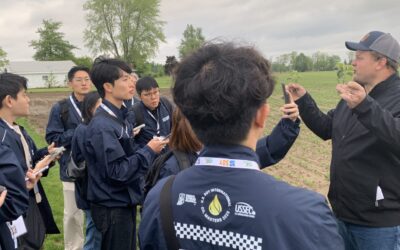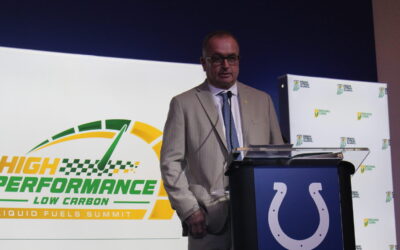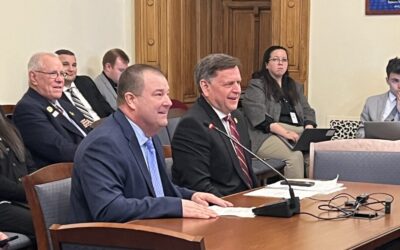USMEF Conference reports U.S. pork exports are on pace to set new record
By Jim Douglas and Mark Legan, USMEF Executive Committee members, Indiana farmers
More than 200 members of the U.S. Meat Export Federation (USMEF) gathered in Tucson, Ariz., recently to set priorities, learn about efforts to promote U.S. beef, pork and lamb around the globe and elect new leadership at the USMEF Strategic Planning Conference.
Steve Hanson, a rancher and cattle feeder from Elsie, Neb., was elected chair, succeeding Minnesota pork and grain producer Randy Spronk.
Hanson praised USMEF for bringing together a wide range of agricultural sectors to support a common goal – something he said was fully on display in Tucson.
“That’s one of the best things about USMEF conferences – the idea that I can attend the Pork Committee and Exporter Committee meetings, to broaden my perspective,” he said. “Yesterday, I sat in on the Exporter Committee meeting so I could learn more about the challenges they face moving product overseas. Those guys have some real hurdles, and this meeting gave me a much greater appreciation for what they do.”
USMEF President and CEO Dan Halstrom shared a positive outlook for red meat exports around the world, noting that pork exports this year are on pace to set a new record on both volume and value. Export sales of U.S. pork are expected to top $8.6 billion.
And while beef exports have been limited by supply constraints, they are still expected to post the second highest value number on record. Beef sales have been buoyed by a rebound in tourism across Asia which has bolstered foodservice that had been slow to bounce back from COVID.
Reviewing U.S. export markets
A highlight of the conference was a producer panel looking at the importance of seeing our export markets firsthand to engage importers, consumers and government officials.
Bob Ruth, a pork producer from Pennsylvania and past president of the National Pork Board, Cattlemen’s Beef Board member Ross Havens of Iowa and Don Pemberton, former president of Kentucky Cattlemen’s Association shared their experiences with USMEF delegations in Korea and Japan. Spronk moderated the panel discussion and shared his own observations from overseas markets.
Pemberton described in detail being surrounded by social media influencers in Korea, eager to learn his grilling technique and share it with their online audiences. He was then surprised by how much attention he received upon his return to Kentucky.
“When I got back to Kentucky, I prepared a trip report and presentation for Kentucky Cattlemen and Kentucky Beef Council. And the next thing I knew, I was on a speaking tour around the state. Because I’d spent 48 hours in Seoul and 48 hours in Tokyo, I was now considered an expert on foreign trade,” laughed Pemberton. “As I presented at more of these meetings, I realized their great interest in how global trade affects them, and more importantly, their checkoff investment. With what I was able to share, they could better understand how their checkoff dollars are invested in global marketing and what a difference this is making.”
Ruth strongly urged those in attendance to make the time to visit our trading partners.
“My advice would be, take a trip. The intelligence that you pick up in the markets is a very valuable experience,” said Ruth.
“The other thing is, and Don had talked about it, and Ross talked about it, is that our customers want to hear from you, the producer. The influence that you have is phenomenal, and your presence there really helps USMEF. It’s going to be valuable for you, and it will be valuable for our industry as well.”
It is a sentiment we strongly share. We both had the opportunity this year to visit Indonesia and see the strong potential for pork sales there. Jim also traveled with USMEF to Japan to interact with consumers there and see firsthand the strong demand for high quality U.S. pork. It is vital for us to learn from our customers and for our customers to know and trust the farmers behind the U.S. product.
Soy growers support for protein exports
United Soybean Board CEO Lucas Lentsch spoke to the Feedgrains and Oilseeds Caucus to underscore the support of soy growers for protein exports.
“I think when you’re looking at return on investment, it’s about market access, and the trend lines are all in the right direction,” Lentsch said.
“If we’re looking at pork and beef being up year-over-year. And the reality is, in a world where tariffs and market access may change with policy, you have to have relationships. And so sometimes the return on investment may be tangible, sometimes it may be intrinsic. That intrinsic value is having a relationship in country that allows you to continue to work through any trade barriers that may exist.”
Other highlights of the Strategic Planning Conference included post-election updates and analysis from Jim Wiesemeyer of Pro Farmer and a look at U.S.-Mexico trade relations as both governments transition to new administrations.
Guest speaker Mateo Diego, a partner with the trade consulting firm AGON, emphasized that the United States and Mexico generally enjoy productive and mutually beneficial trade, but cautioned that there are “irritants” that could disrupt this relationship. He noted that the U.S.-Mexico-Canada Agreement (USMCA) is up for review in 2026 and urged conference attendees to speak up and voice their support for USMCA.
USMEF members will next meet at the organization’s Spring Conference, May 21-23 in Fort Worth, Texas.
Jim Douglas is a farmer from Flat Rock, Ind. Douglas is a United Soybean Board (USB) member, and he represents USB on the USMEF Executive Committee.
Mark Legan is a farmer from Coatesville, Ind. Legan is a board member of the Indiana Soybean Alliance, the state’s soybean checkoff program. He is a member of the USMEF Executive Committee representing oilseed producers.
Posted: November 16, 2024
Category: ICMC, Indiana Corn and Soybean Post - November 2024, ISA, Market Development, News



